Ever Wonder What Makes a Great Cup of Coffee?
Great Coffee Only Happens With Knowledge and Expertise in 3 Key Elements:
The Bean, the Roast, and the Brew.
Of course, for each key element, whole books have been written to discuss the topic. Below is an overview of the three key elements and a discussion of the more important topics and details therein.


THE BEAN
There are, in fact, over 120 different species of coffee trees. Within those species only two are commercially produced: Coffea Arabica and Coffea Canephora (commonly referred to as Robusta). However, when people talk about the mighty coffee bean they are most likely referring to the seed from the fruit from the Coffea Arabica tree. Generally speaking, Robusta coffee is considered the lesser of the two coffees. It grows better at different altitudes and temperatures than the Arabica coffee tree and is more disease resistant. These qualities make it cheaper to produce and that drives its production. However, it does’t taste very good. Robusta taste earthy and is often said to have a bitter rubbery flavor. Robusta beans contain 50% more caffeine and less sugar than Arabica beans, and therefore taste stronger and harsher. Most of the Robusta beans grown come from Vietnam and end up on store shelves as instant soluble coffee.
The Coffea Arabica species is generally considered the more suitable coffee. Arabica makes up the vast majority of coffee produced each year and is grown in many regions around the world inside what is known as the Coffee Belt. As seen above, the coffee belt lies equidistant from the equator between the Tropic of Cancer and the Tropic of Capricorn. Very generally speaking, Arabica coffee has a sweet mild taste with notes of berries, fruits, and sugar. Of course, within the Arabica coffee species, there are a great many varieties grown in different regions around the world. Each region and variety, along with the way they are cultivated, processed, and roasted offer many unique and distinctive flavor profiles!
As mentioned, the coffee bean is actually a seed picked from the fruit from a coffee tree. The picture above shows the fruit of a coffee tree; commonly referred to as coffee cherries. They are hand picked or machine harvested. After harvest they are processed to remove the outer husk of skin and fruit to leave you with the green coffee seed (bean). The two main types of processing coffee are the Natural Process and the Washed Process. Both offer different outcomes to the final cupping of a specific coffee.

THE ROAST
Roasting coffee seeds (beans) is one of the most fascinating, if not enjoyable, parts in the journey of coffee. From large commercial roasters to a growing specialty coffee industry roasting coffee is as complex as it is rewarding. Many local roasters/coffee shops are starting to place their roasting drums in sight of its customers. As soon as a patron walks through the doors they are hit with a cerebral symphonic explosion of the senses. The green coffee seeds are transformed into an incredibly aromatic and complex coffee “bean” that we all know. Typically speaking, green coffee beans are imported in 60 kg (132 lbs) burlap bags. They can be stored for long periods of time if kept in a climate controlled room temperature area. Of course, like many things, its better to not let your green coffee sit on shelves for an extended period of time.
During the roasting process the green coffee beans go through several stages. Each step adds depth and character to the overall roast profile and many roasters will track their individual roast batches in a effort to duplicate a similar roast the next time. The individual stages are as follows.
Stage 1: Drying
Raw coffee contains 8-10% water by weight. The very first stage in roasting coffee evaporates the water and allows for the drying process to begin. Once there is no water left the eventual browning of the coffee beans occur.
Stage 2: Yellowing
Once the water is completely evaporated, yellowing of the beans occur. The beans are still dense and the chafing (the thin skin surround the beans) will fall off.
Stage 3: First Crack
Once the yellowing reaction gains in speed due to an increase in heat being transferred into the beans the coffee will give off a cracking noise. This is due to a build up of CO2 and water vapor. This stage marks the first time a roaster can end the roasting process and is the first time the coffee gives off the familiar flavors and aromas we are use to and recognize as coffee.
Stage 4: Roast Development
At this stage a roaster can control the balance of bitterness and acidity in the end product. The acids in the beans are rapidly degrading while the level of bitterness increases as the roasting continues.
Stage 5: Second Crack
Once this stage is reached you will hear a second less pronounced “cracking” noise. At this stage, you will notice the oils being driven to the surface of the coffee beans creating a shiny-glossy look.. This stage typically marks the last stage of roasting and signifies a dark roast. Common names to describe this level of dark roast include “French Roast” and “Italian Roast.” Most of the acidity will have been roasted out and you are left with a more bitter higher body flavor profile. Many coffees are suitable to roast to this degree but to enjoy higher quality coffees from different regions you should roast to a lesser degree to experience the nuanced flavors and characteristics of a specific coffee.
————————-
As mentioned, the green coffee beans are transformed several times before the desired roast profile is achieved. A very simple and common way of describing roast profiles is to describe them as light, medium, and dark roasts. However, that only refers to the color of the end product. A coffees flavor profile is achieved by two key factors: the time and temperature in which the coffee is roasted. To simply describe coffee as medium or dark roast is insufficient as two separate coffee beans of the same color could have been roasted for a longer or shorter period of time. This, in turn, creates quite a different flavor despite the beans appearing the same color. Generally speaking, a slower roast yields a better cup of coffee. Many different chemical reactions occur as a result of roasting coffee and experienced roast masters can experiment with the time and temperature to create unique flavor profiles. In the great pantheon of terms used to describe a coffees flavor three main flavor notes are at the forefront. The roasting process can be controlled to determine the bitterness, acidity, and sweetness. A good roast master knows how long and at what temperatures to roast a specific type of coffee.

THE BRew
The third, final, and perhaps most important key element in creating a great cup of coffee is the brewing process. All the hard work that has gone into creating your coffee, the tried and true harvesting, processing, and roasting techniques, the many thousands of miles the beans have traveled, and especially the locked in deliciousness of a perfectly roasted bean can be ruined in the span of 5 minutes by improper brewing techniques. It is upsetting to know that many people go out of their way to buy high end specialty grade coffee only to fail to follow proper brewing techniques. Understanding some basic principles can lead to a better more consistent cup of coffee and make the brewing process more enjoyable.
Coffee-to-Water Ratio
A general guideline is called the Golden Ratio. Use one to two tablespoons of ground coffee for every six ounces of water. This can be adjusted to suit individual taste. For a full pot of coffee (72 ounces) you need to add 12-24 tablespoons of ground coffee.
Water Temperature
Your brewer should maintain a water temperature between 195 to 205 degrees Fahrenheit for optimal extraction. Colder water will result in flat, under-extracted coffee, while water that is too hot will also cause a loss of quality in the taste of the coffee.
Brewing Time
The amount of time that the water is in contact with the coffee grounds is another important factor in brewing coffee. In a standard drip system, the contact time should be approximately 5 minutes. If you are making your coffee using a French Press, the contact time should be 3-4 minutes. Espresso has an especially brief brew time with the coffee being in contact with water for about 20 to 30 seconds. Cold brew, however, should steep for about 12 hours using filtered room temperature water.
Please check back frequently to learn more about the proper brewing techniques for the each type of brewing methods.

